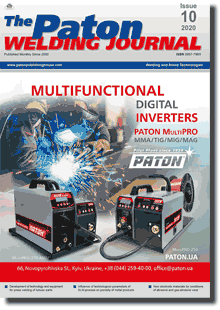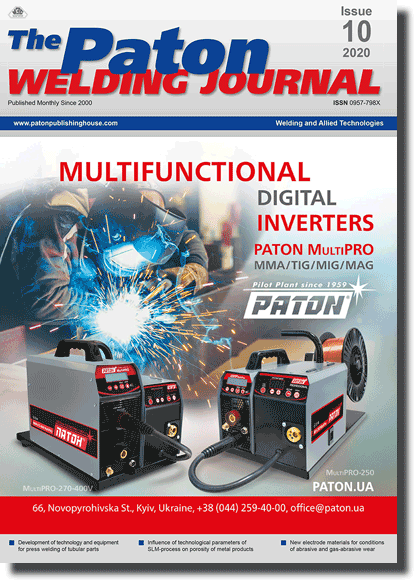| 2020 №10 (04) |
DOI of Article 10.37434/tpwj2020.10.05 |
2020 №10 (06) |

The Paton Welding Journal, 2020, #10, 23-30 pages
Influence of amplitude and frequency of oscillations of electrode wire in arc surfacing on formation and structure of the deposited metal and penetration of base metal
A.A. Babinets, I.O. Ryabtsev, I.P. Lentyugov, I.I. Ryabtsev, T.V. Kaida and I.L. Bogaichuk
E.O. Paton Electric Welding Institute of the NAS of Ukraine 11 Kazymyr Malevych Str., 03150, Kyiv, Ukraine. E-mail: office@paton.kiev.ua
Abstract
The influence of amplitude and frequency of oscillations of electrode wire during arc surfacing on formation of deposited beads, nature of base metal penetration, as well as structural and chemical heterogeneity in the zone of the joint of deposited and base metals were studied. It was established that an increase in the frequency of oscillations of electrode wire, at the same amplitude of oscillations and rate of deposition, leads to an improvement in formation of the deposited metal and mixing of the layers in the deposited metal; formation of a more dispersed structure; narrowing of the transition zone; more uniform distribution of alloying elements; more uniform penetration and «smoothing» of the fusion boundary of the deposited and base metal. The mentioned regularities almost do not change with an increase in the amplitude of oscillations. It was established that the best formation of the deposited metal occurs at the maximum frequency N = 45 min‒1 and amplitude of oscillations of the electrode wire A = 25 mm and deposition rate Vd = 7 m/h. 8 Ref., 2 Tables, 10 Figures.
Keywords: arc surfacing, electrode wire oscillation, amplitude and frequency of oscillations, base metal penetration, deposited metal formation, deposited metal structure, structure heterogeneity
Received 09.09.2020
References
1. Danilchenko, B.V., Shimanovsky, V.P., Voronchuk, A.P., Terpilo, V.N. (1989) Hard-facing of rapidly wearing parts by self-shielded flux-cored strips. Avtomatich. Svarka, 5, 38–41 [in Russian].2. Zhudra, A.P., Voronchuk, A.P., Fomakin, A.A., Veliky, S.I. (2009) New equipment for hard-facing of charging device bells and cups. The Paton Welding J., 9, 44‒46.
3. Zhudra, A.P., Krivchikov, S.Yu., Petrov, V.V. (2010) Technology for wide-layer hard-facing of crankshafts. Ibid., 2, 32‒35.
4. Gulakov, S.V., Burlaka, V.V. (2010) Mechanism of electrode oscillation for formation of deposited beads of complex shape. Vestnik Priazov. GTU. Tekhnicheskie Nauki, 20, 181–186 [in Russian].
5. Spiridonov, N.V., Kudina, A.V., Kurash, V.V. (2013) Electric arc shielded-gas hard-facing of metal surfaces with oscillating electrode. Nauka i Tekhnika, 4, 3–8 [in Russian].
6. Goloborodko, Zh.G., Dragan, S.V., Simutenkov, I.V. (2013) Automatic submerged-arc surfacing of structural steels with transverse high-frequency movements of electrode. The Paton Welding J., 6, 34‒37.
7. Babinets, A.A., Ryabtsev, I.A., Kondratiev, I.A. et al. (2014) Investigation of thermal resistance of deposited metal designed for restoration of mill rolls. Ibid., 5, 16-20. https://doi.org/10.15407/tpwj2014.05.03
8. Ryabtsev, I.A., Babinets, A.A. (2015) Fatigue life of multilayer deposited specimens. Svarochn. Proizvodstvo, 4, 15–19 [in Russian].
Suggested Citation
A.A. Babinets, I.O. Ryabtsev, I.P. Lentyugov, I.I. Ryabtsev, T.V. Kaida and I.L. Bogaichuk (2020) Influence of amplitude and frequency of oscillations of electrode wire in arc surfacing on formation and structure of the deposited metal and penetration of base meta. The Paton Welding J., 10, 23-30.The cost of subscription/purchase order journals or individual articles
| Journal/Currency | Annual Set | 1 issue printed |
1 issue |
one article |
| TPWJ/USD | 384 $ | 32 $ | 26 $ | 13 $ |
| TPWJ/EUR | 348 € | 29 € | 24 € | 12 € |
| TPWJ/UAH | 7200 UAH | 600 UAH | 600 UAH | 280 UAH |
| AS/UAH | 1800 UAH | 300 UAH | 300 UAH | 150 UAH |
| AS/USD | 192 $ | 32 $ | 26 $ | 13 $ |
| AS/EUR | 180 € | 30 € | 25 € | 12 € |
| SEM/UAH | 1200 UAH | 300 UAH | 300 UAH | 150 UAH |
| SEM/USD | 128 $ | 32 $ | 26 $ | 13 $ |
| SEM/EUR | 120 € | 30 € | 25 € | 12 € |
| TDNK/UAH | 1200 UAH | 300 UAH | 300 UAH | 150 UAH |
| TDNK/USD | 128 $ | 32 $ | 26 $ | 13 $ |
| TDNK/EUR | 120 € | 30 € | 25 € | 15 € |
AS = «Automatic Welding» - 6 issues per year;
TPWJ = «PATON WELDING JOURNAL» - 12 issues per year;
SEM = «Electrometallurgy Today» - 4 issues per year;
TDNK = «Technical Diagnostics and Non-Destructive Testing» - 4 issues per year.


